All about underfloor heating in the baths
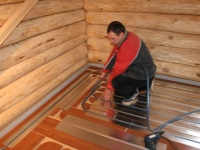
These days, the arrangement of warm floors in a variety of rooms has become quite commonplace, and you can now find such heating systems almost everywhere. No exception in this case, bathing complexes and saunas. It is for this reason that the number of those who are interested in everything about underfloor heating in the bath is constantly increasing. It is not only about the choice of equipment, but also about the peculiarities of the installation of such heating and the possibility of performing the work with their own hands.
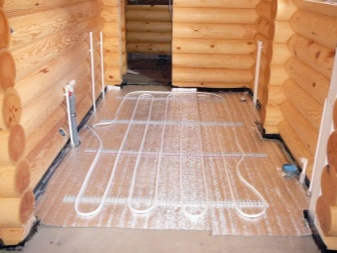
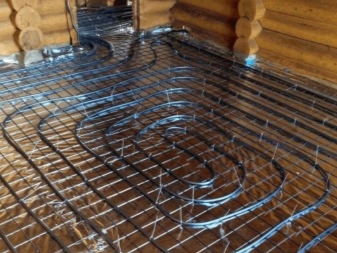
Device and principle of work
Undeniable is the fact that a warm floor in a wooden bath will be more than a useful addition, which will form the most comfortable microclimate in the room. By the way, some people think the arrangement of such heating systems is almost useless, because in the steam room from the furnace or boiler and so comes a sufficient amount of heat. However, this is largely a false assertion.
The need for additional heating is justified by important points.
- As you know, the hot air always rises up, accumulating under the ceiling. Regardless of the temperature in the room below, it will inevitably be noticeably colder. The heat coming from the floor can correct the situation.
- An integral part of the steam room in the Russian bath is manipulation with the brooms, because of which there are always puddles on the floor. Heating in this situation is able to effectively get rid of excess moisture, and, therefore, prevent the need for replacement or frequent treatment of the coating.
- Heating system allows you to reduce the load on the main sources of heat in the steam room. This is most relevant when using an electric boiler.
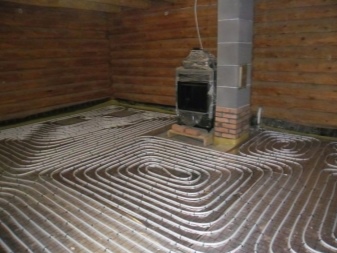
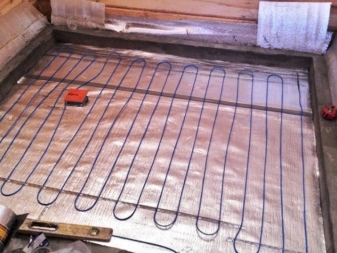
The sauna floor heating systems that exist today can be divided into two groups.
- Closed circuit of water pipes.
- Electrical systems, the main component of which are special cables or infrared mats.
Naturally, each of the options has its clear advantages, as well as no less significant disadvantages. In this case, choosing a particular method of arrangement of a warm floor, you should consider a whole list of important criteria.
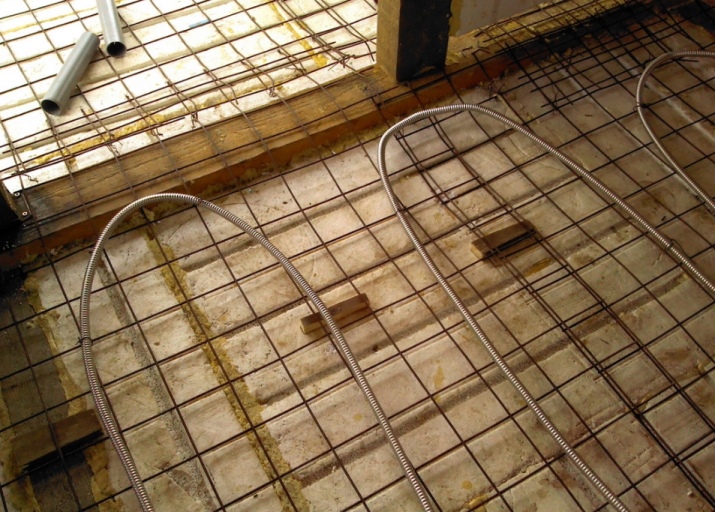
Types
Relatively recently, the main source of heat in the described structures were furnaces. More modern equipment, of course, is characterized by safety, reliability and performance. At the same time, the installation of the heating system under the flooring provides a variety of options for equipping the bath. At the moment we can distinguish three main types of underfloor heating, which will be discussed below.
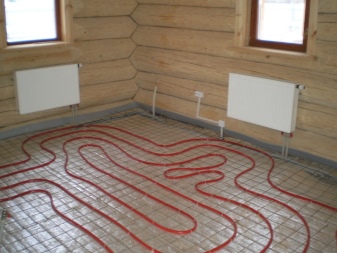

Electric
In this case, initially we will talk about the system, the main (heating) element of which is a heat cable. The undeniable advantages in this case include:
- relatively low cost;
- maximum service life;
- intuitive operation;
- ease of installation.
The main disadvantage of using electric cable is the relatively slow heating of the floor. It is also worth taking into account the need for a solid coating, i.e. screed.

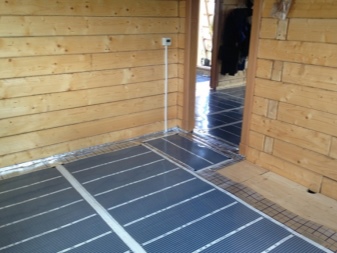
Given all the performance indicators, heat cables are quite suitable for installation in rooms with high humidity. At the same time, it is strongly recommended to pay attention to what is necessary:
- take care of high-quality and properly made grounding;
- install RCD;
- when installing the system to use the appropriate type of cables (taking into account the increased humidity).
According to current statistics and numerous reviews, when installing heating systems by yourself, most often the choice is made in favor of electric mats. They compare favorably with the cable with maximum ease of installation.
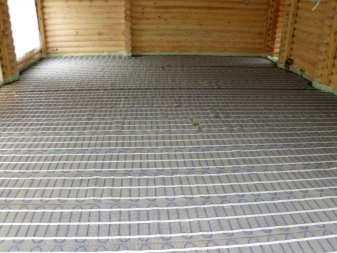
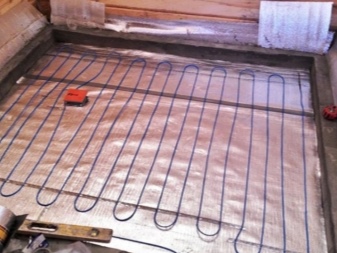
Water
This option - this is today, perhaps, the easiest and most budgetary way of creating an insulated floor covering in the bath. First of all, it is worth noting that such heating systems are as safe as possible, since there is no risk of electric shock. However, as in the first case, to increase efficiency and protect the elements of the structure will require the creation of a concrete screed. Inside this layer, flexible water pipes will be located.
As a water heating element can be used various appliances and devices. However, if you have a sauna stove, it will be the most profitable and rational solution. Regardless of the choice of heater, the water underfloor heating system includes:
- a heating circuit, made of pipes, located at a certain distance from each other;
- Mixing unit, this module is responsible for regulating the temperature indicators and maintaining them at a predetermined level;
- heat exchanger - a tank in which the heating medium is heated.
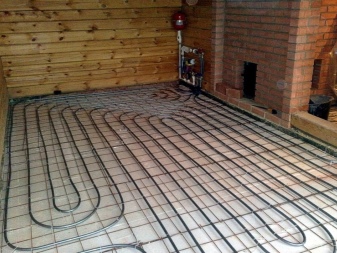
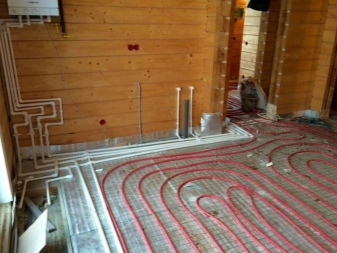
The main advantages of such a heating system include:
- the complete absence of electromagnetic radiation;
- eco-friendliness;
- economy (we mean the systems connected to the sauna stove);
- a gradual increase in temperature.
Naturally, water floors also have certain disadvantages, namely:
- laboriousness of installation;
- increase in the thickness of the floor due to the height of the ceilings because of the need for screed;
- the need to drain the coolant from the system in the winter time during long breaks in the operation of the bath;
- when heating multiple rooms (steam room, washing room, anteroom, etc.) increase the time of heating the system.
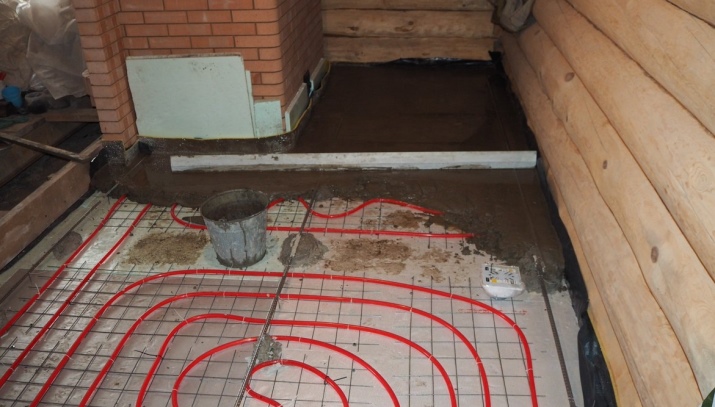
Infrared
Answering the question of what is the main element of such a heating system, it should be noted that there is a polymer film, in which the heating elements are sewn into. Her functioning is based on the conversion of electrical energy into infrared radiation. One of the main features of this type of heating is that after turning on the system is not heated air, namely the floor covering.
This type of underfloor heating is relatively new, but in record time has been able to prove itself in an extremely positive way. This is due to the following clear advantages of IR systems:
- safety;
- economy;
- maximum reliability provided, above all, by high resistance to damage.
- ease of installation;
- the fastest possible heating of the film to the selected operating temperature.
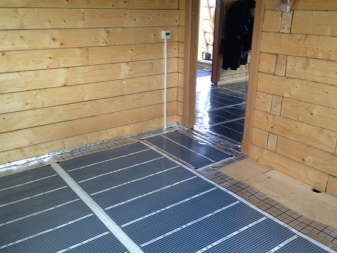

Speaking about the disadvantages of infrared floors, it is worth focusing on the negative impact of high humidity on the heating elements, as well as the risk of water ingress. In such cases, there is a high probability of oxidation of the plates and contacts, which will lead to the failure of the system. On this basis, their installation, as a rule, is not relevant for steam rooms and washing rooms.
When carrying out work, it is strongly recommended to take care to have a reliable grounding and the installation of a ground fault interrupter.

Advantages and disadvantages of installing underfloor heating in baths
In accordance with the principle of air circulation, warm masses tend upwards, while cold masses gather near the floor covering. In order to create the most comfortable conditions in the bath in such a situation, especially for steaming people, it will not be superfluous to additionally warm the floors. It is important to consider that the presence of radiators as part of a traditional heating system is unlikely to change the situation significantly. And the result, unfortunately, can be colds.
If we compare the already mentioned classic heating and underfloor heating system, the latter option is characterized by the following undeniable advantages:
- Creation of an optimal and most comfortable microclimate for the duration of bathing procedures;
- Effective drying of the wooden flooring, preventing the negative consequences of fungus and rot;
- prevention of draughts.
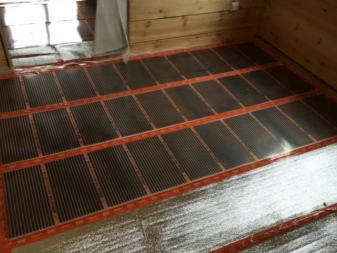
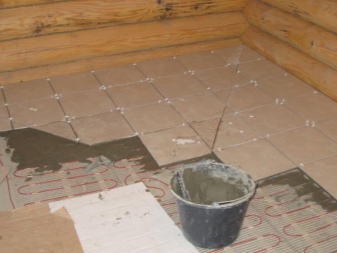
As you know, nothing is perfect, and therefore the installation of underfloor heating systems in baths has certain disadvantages. First of all, you should pay attention to the financial costs associated with the purchase of the necessary equipment and consumables. It is also necessary to take into account the labor intensity of installation, and in some cases the need for repair work in the room.
However, for the sake of justice, it should be noted that all the disadvantages are fully offset by the above advantages of the described heating systems.
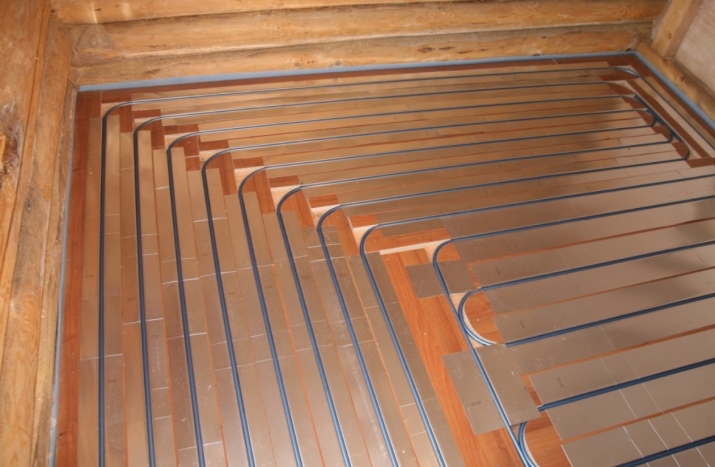
Which one is better to choose?
As noted, to date, manufacturers offer potential customers and buyers three options for the arrangement of warm floors. Naturally, each of the existing systems has both clear advantages and disadvantages. It is these important points that will be the key criteria for choosing a particular installation scheme and the materials used in this process.
According to user reviews, professional reviews and opinions of experts, one of the important points is the peculiarities of installation of the system and the nuances of its operation. In addition, it is strongly recommended to take into account the current requirements for the equipment of the premises, taking into account the operation of heating in conditions of high humidity.
From a financial point of view, the most profitable solution will be water underfloor heating. This will be most relevant if there is a sufficiently powerful sauna stove in the steam room, which will serve as the main heating element. However, in such a situation, experts advise to take into account the need to arrange an appropriate coating.
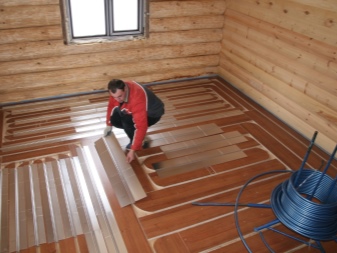
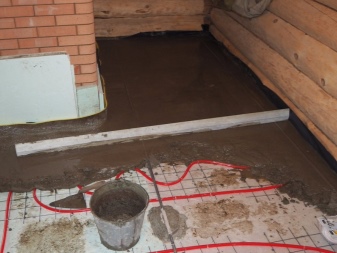
Now many people recommend opting for infrared structures. This is largely due to the maximum ease of installation and the absence of the need to install a heater. Even taking into account the cost of paying for the electricity consumed, this option is rational.
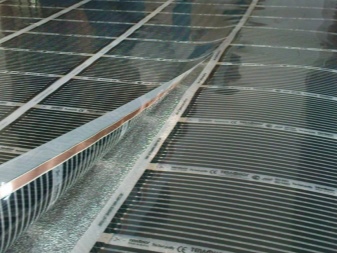
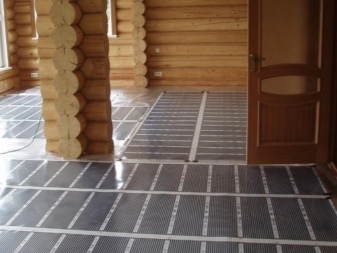
Of course, the choice of a particular type of underfloor heating is a personal matter for each owner of a bath or sauna. Most often, the key criteria are personal preferences. No less important factor is the financial side of the issue and the design features of the room.
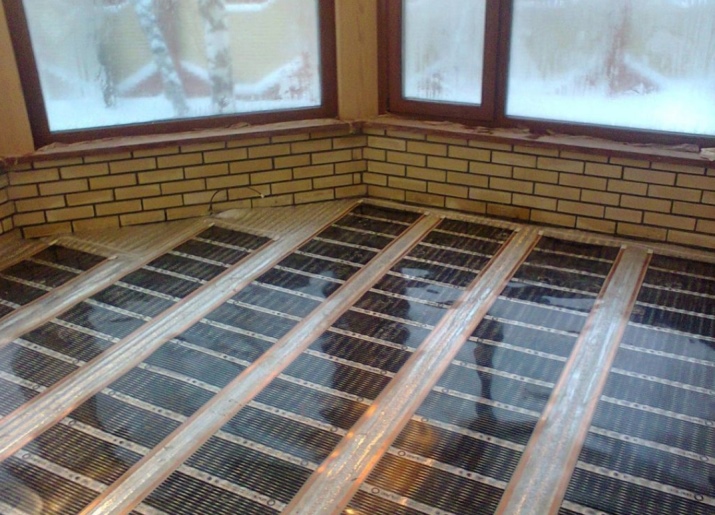
Where to place?
First of all, it should be taken into account that the bath is quite a specific construction. The main features of such a room include high humidity and an appropriate temperature regime. It is also important to remember that almost the entire surface of the flooring is the collection and subsequent drainage of water. It is these moments determine the requirements for finishing materials, the use of which is allowed in the arrangement of the bath. Most often we are talking about wood, but you can also find floors covered with tiles.

The choice of location for the installation of underfloor heating largely depends on all of the above. So, some homeowners opt for a shared heating system. The main advantage in this case is the absence of room differentiation. However, it is worth focusing on the cost of implementing such an idea, that is a solid investment in the equipment of a non-residential building. In addition, attention should be paid to the important disadvantages of a common underfloor heating, which include:
- Injury hazard of wet tile flooring with gradients for water drainage;
- increased inertia of the system;
- significant time costs for heating the screed;
- when installing water systems, there is a risk of defrosting the system;
- the need for sufficient space to install heaters and control units.
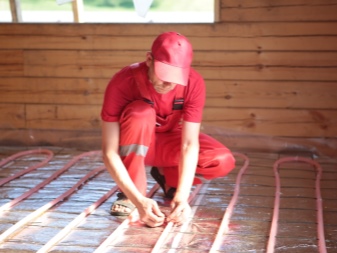
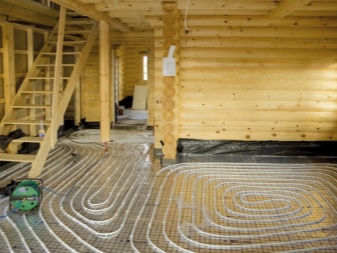
Given all of the above, we can conclude that this option is relevant mainly for large baths and complexes. For a small room in a private home, it is more rational to choose another scheme. And it is, above all, the so-called differentiated approach. In this case, the installation of two or more autonomous systems is provided.
It all depends on the number and specifics of the available rooms, but most often the floor heating is done separately for the pre-bath and the washing room. In this case, in the first case, it is quite suitable infrared models, since in the pre-bath the level of humidity is significantly lower.
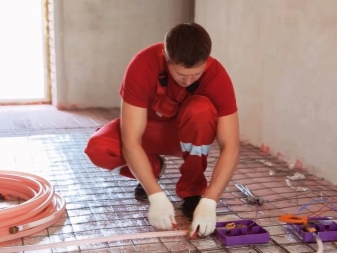
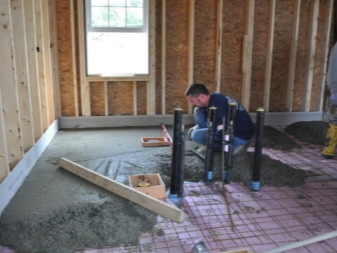
How to make it with your own hands?
First of all, you will need to take care about the availability of the necessary materials, as well as equipment and tools. In situations with water and electric (cable) underfloor heating it will be necessary to pour a screed, and in some cases a concrete foundation. For this you will need mortars, reinforcing mesh, concrete mixer, rule, trowel. This, of course, is not a complete list.
Among other things, when installing heating systems of this type use thermal and waterproofing materials.
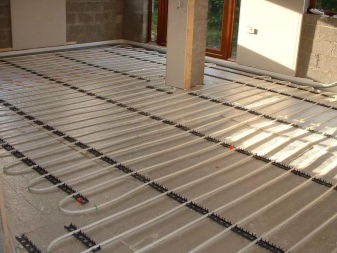
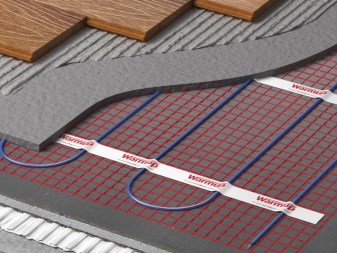
Surface preparation
As already noted, the material for the floor covering in baths is wood or modern tiles. The latter option involves the mandatory presence of a screed, which, by the way, does not retain heat very well. Based on such characteristics, it is necessary to take care of an effective thermal insulation layer. For its creation, various materials are used, the list of which includes expanded clay, felt, foam, mineral wool and others.
Experienced experts advise placing insulation between two layers of concrete base. In this case, the upper can be done thinner than the base in order to save space in the room. When installing the described systems, it is necessary to take into account the level of humidity in the bath. On this basis, all structural elements should be treated accordingly.
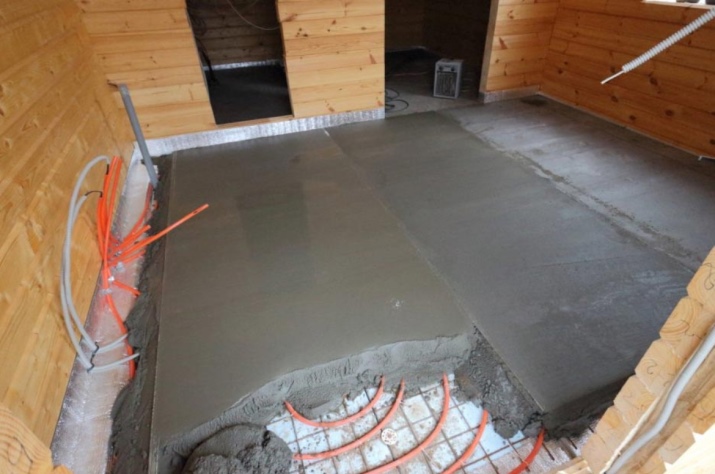
When erecting the base, you should consider the need for slopes to collect water. The minimum value in this case is 20 mm/m. It is important to remember that the slope should not be towards the center of the room. Along the walls, as a rule, a small gutter is made. One of the easiest ways in this case is the use of plastic sewer pipes with a diameter of 100 mm cut along.
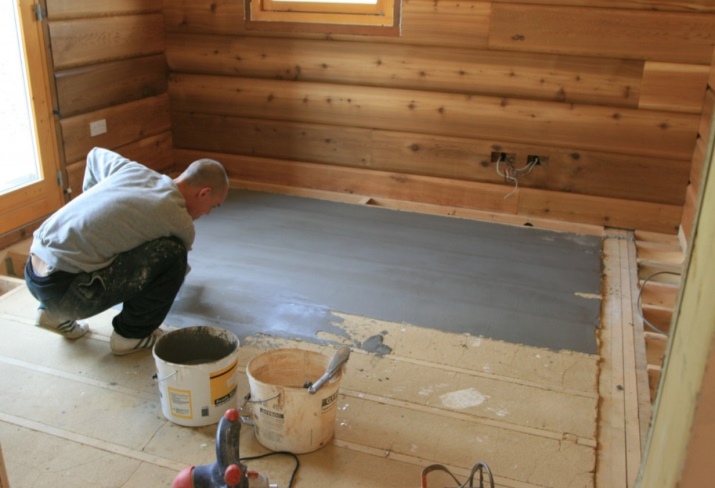
Installation scheme
After the construction of the foundation, if required, and the screed, proceed to the installation of the heating system itself. If the variant with the use of heat cable is chosen, then it is pre-distributed evenly over the entire surface. It is not recommended to place heating elements in places where furniture will later be installed. The same is done with mats. By the way, their power is 150 W/sq. m, on the basis of which it is necessary at the stage of preparation to calculate the scheme of arrangement.
If the choice is made in favor of the infrared film, then the algorithm of actions will look as follows:
- calculation of the required amount of material and its preparation;
- Thorough removal of debris and dust from the surface;
- high-quality insulation of all sections of the heating elements;
- location of the film in accordance with the previously developed scheme;
- laying of the thermal insulation coating and its fixation with adhesive tape;
- laying and fixing the infrared film itself;
- Connecting the channels to the power cable and securing them with special clamps;
- Impregnation of the joints.
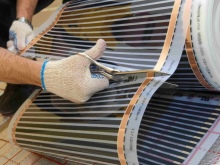
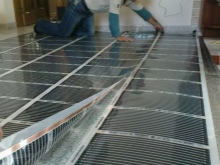
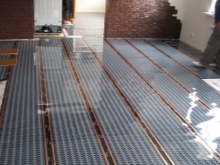
When installing a water heated floor, it is necessary to first determine the location of the pipes. As a rule, two options are used - "snail" and "snake". In this case, the first scheme is the most successful for the bath, as it provides uniform heating of the surface.
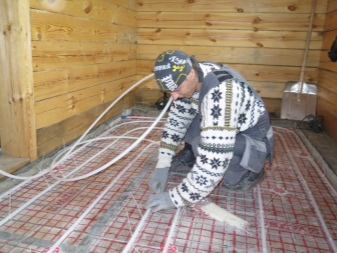
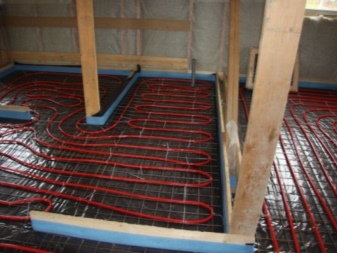
The final stage
After installing the heating elements of water and electric underfloor heating it is necessary to create a finished floor covering. This is often done by first laying a screed inside which the pipes or heating cable (mats) will be placed. As a finishing material in this case use both wood and floor tiles. In some cases, the floor is simply left as concrete. At the final stage, it is necessary to pay special attention to the design of previously installed water drains.
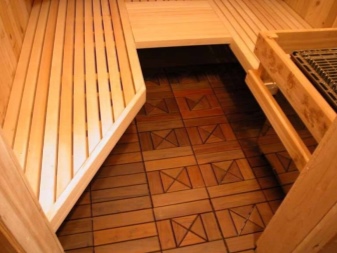
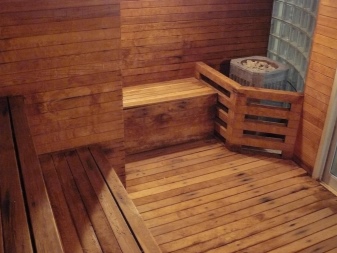
Frequent mistakes during installation
In principle, independent installation of the heating system in the floor is a fairly simple process. However, due to a lack of knowledge, mistakes are made that negatively affect the efficiency of the heater. To avoid such a thing, it is worth heeding some recommendations.
- When calculating, do not take into account the entire area of the room, but only the area where there will be no furniture.
- It is extremely undesirable to shorten the heat cable, thereby increasing the load.
- When screeding, it is forbidden to turn on the system before the concrete (mortar) is completely dry.
- Heating elements must not be laid on a dirty surface.
- The intervals between the elements must be at least 5 cm.
- Sensors are installed in an accessible place and provide them with reliable protection.
- When laying pipes, cables, mats and infrared film, it is necessary to act carefully and avoid damaging them.
To summarize, it should be recalled that the most rational approach will be to calculate the installation of a warm floor already at the stage of construction of the bath. Equally important will be the observance of all rules and regulations. Separate attention should be paid to the safety requirements for the installation of electrical systems.
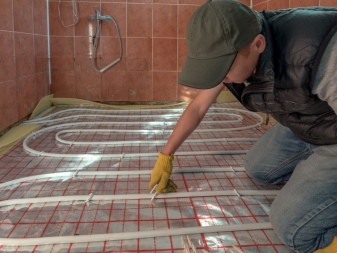
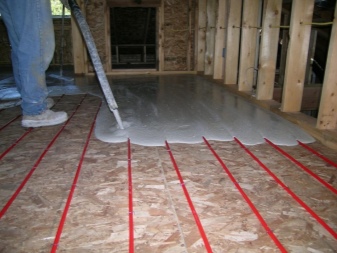
The following video talks about warm floors in the bath.




